PONTIAC BONNEVILLE 1996 Owners Manual
Manufacturer: PONTIAC, Model Year: 1996, Model line: BONNEVILLE, Model: PONTIAC BONNEVILLE 1996Pages: 387, PDF Size: 18.71 MB
Page 281 of 387

Rear Quarter Tail/Stop/Turn SignaUSidemarker
Lamps
For bulb type, see “Replacement Bulbs” in the Index.
3. Turn the bulb assembly counterclockwise to remove it.
1. Remove the plastic nut holding the cqhg in place.
2. Pull the carpeting away from the rear corner of
the trunk.
6-36
ProCarManuals.com
Page 282 of 387
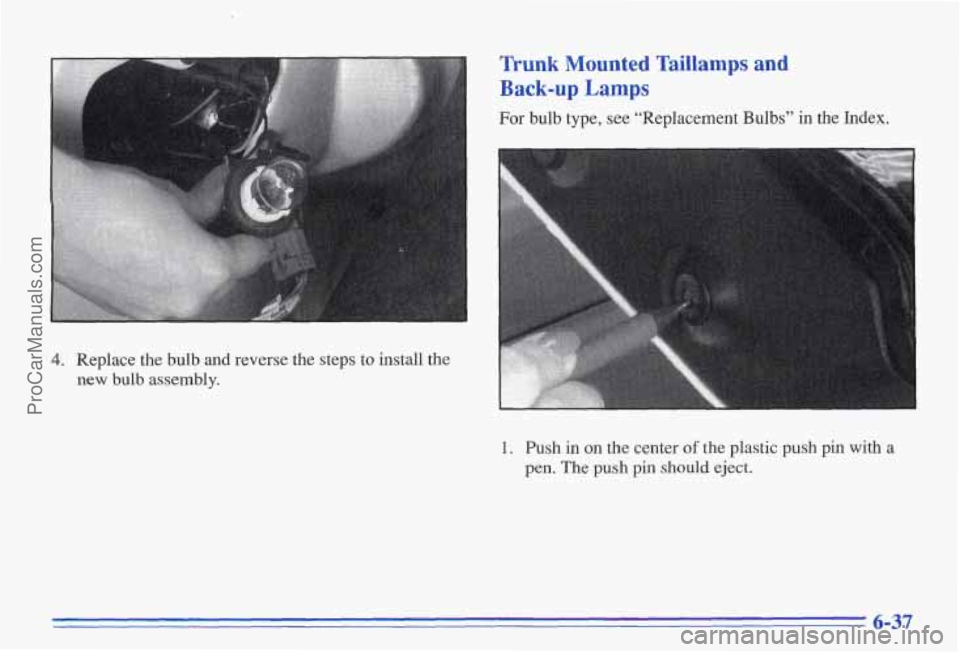
Runk Mounted Taillamps and
Back-up Lamps
For bulb type, see “Replacement Bulbs” in the Index.
.ll the 4. Replace the bulb and reverse the steps to insta
new bulb assembly.
1. Push in on the center of the plastic push pin with a
pen. The push pin should eject.
6-37
ProCarManuals.com
Page 283 of 387
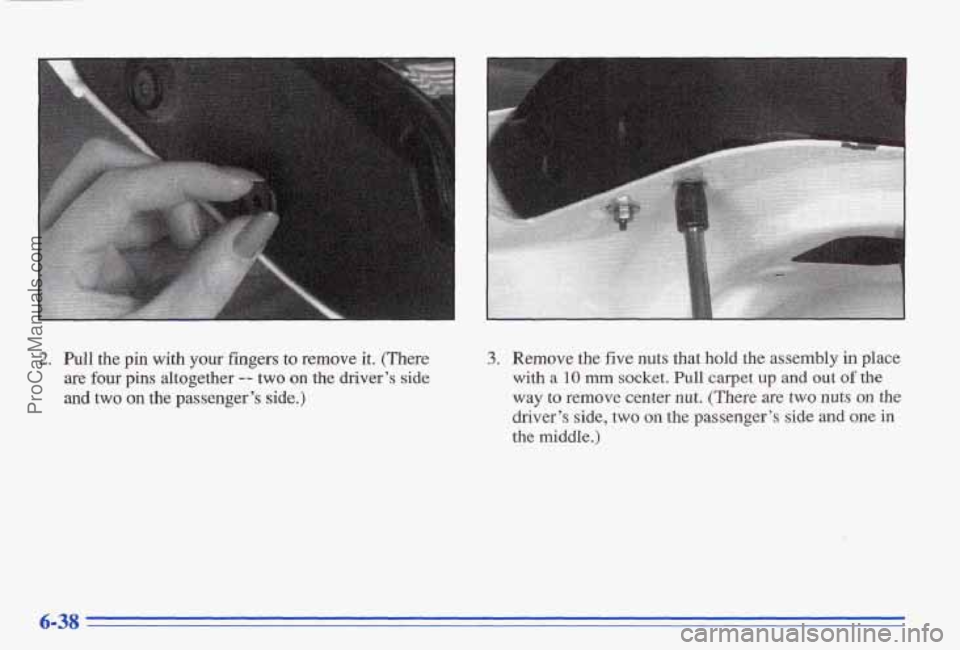
2. Pull the pin with your fingers to remove it. (There
are
four pins altogether -- two on the driver’s side
and two
on the passenger’s side.)
3. Remove the five nuts that hold the assembly in place
with a 10 mm socket. Pull carpet up and out of the
way to remove center nut. (There are two nuts on the
driver’s side, two on the passenger’s side and one in
the middle.)
ProCarManuals.com
Page 284 of 387
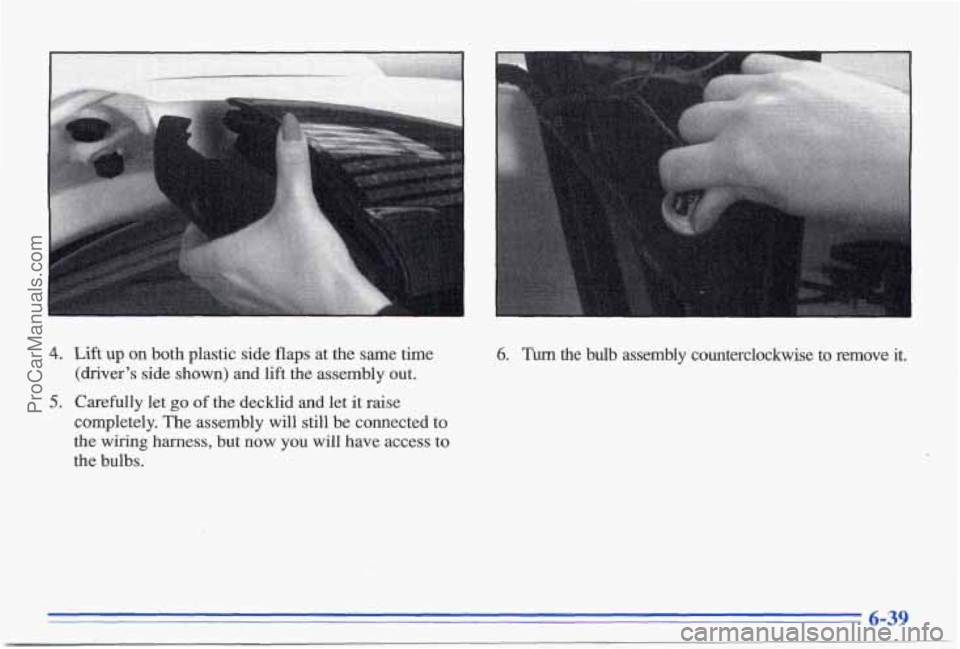
4. Lift up on both plastic side flaps at the same time
(driver’s side shown) and lift the assembly out.
5. Carefully let go of the decklid and let it raise
completely. The assembly will still be connected to
the wiring harness, but now you
will have access to
the bulbs.
6. Turn the bulb assembly counterclockwise to remove it.
ProCarManuals.com
Page 285 of 387

7. Pull out the taillamp bulb to remove it. 8. If you are replacing the back-up bulb, it must be
9. Reverse the steps to install the new bulb assembly. turned and pulled
but to be removed.
6-40
ProCarManuals.com
Page 286 of 387
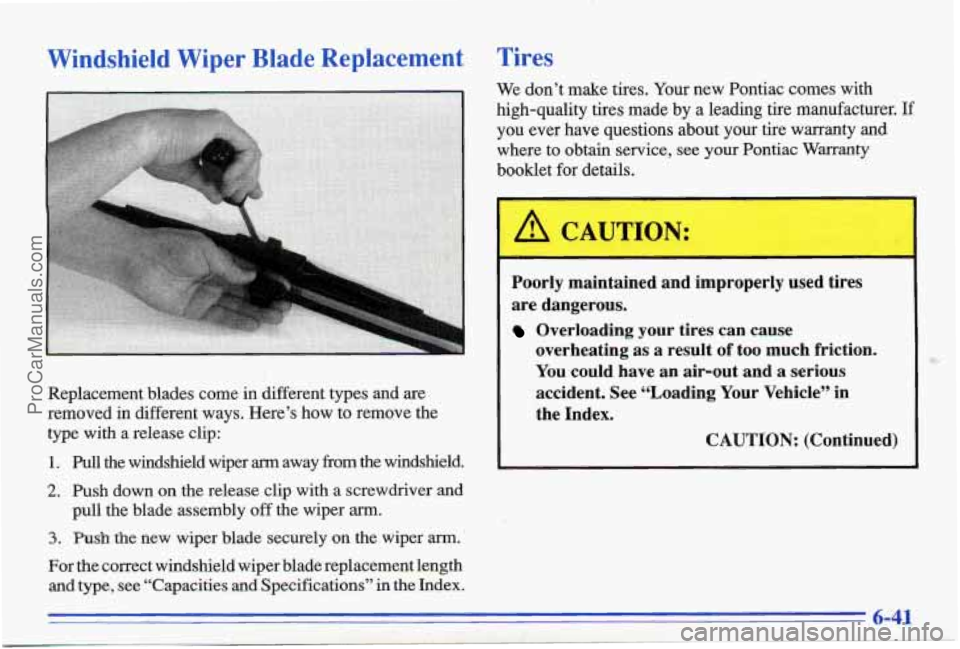
Windshield Wiper Blade Replacement
Replacement blades come in different types and are
removed in different ways. Here’s how to remove the
type with a release clip:
1. Pull the windshield wiper arm away fiom the windshield.
2. Push down on the release clip with a screwdriver and
3. Push the new wiper blade securely on the wiper arm. ’
For the correct windshield wiper blade replacement length
and type, see “Capacities and Specifications’’ in the Index.
pull
the blade assembly
off the wiper arm.
Tires
We don’t make tires. Your new Pontiac comes with
high-quality
tires made by a leading tire manufacturer. If
you ever have questions about your tire warranty and
where to obtain service, see
your Pontiac Warranty
booklet
for details.
1 A CAUTION:
Poorly maintained and improperly used tires
are dangerous.
Overloading your tires can cause
overheating as a result
of too much friction.
You could have an air-out and a serious
accident. See “Loading Your Vehicle” in
the Index.
CAUTION: (Continued)
6-41
ProCarManuals.com
Page 287 of 387
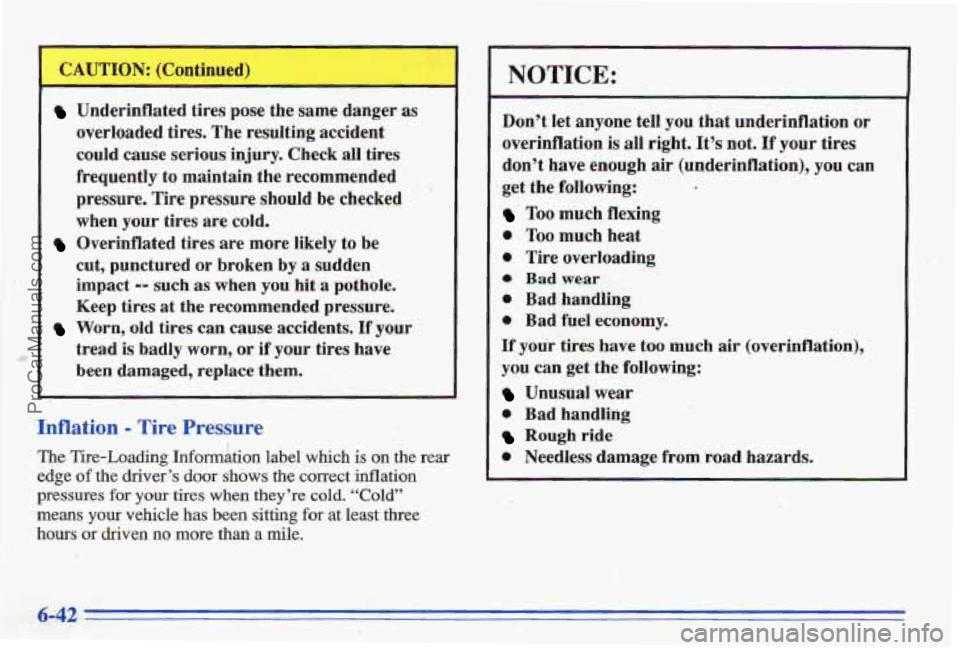
Underinflated tires pose the same danger as
overloaded tires. The resulting accident
could cause serious injury. Check all tires
frequently to maintain the recommended
pressure. Tire pressure should be ch’ecked
when your tires are cold.
cut, punctured or broken
by a sudden
impact
-- such as when you hit a pothole.
Keep tires at the recommended pressure.
Worn, old tires can cause accidents. If your
tread is badly
worn, or if your tires have
been damaged, replace
them.
Overinflated tires are more likely to be
Inflation - Tire Pressure
The Tire-Loading Informkion label which is on the rear
edge of the driver’s door shows the correct inflation
pressur,es
for yow tires when they’re cold. “Cold”
means your vehicle has been sitting for at least three
hours
or driven no more than a mile.
NOTICE:
Don’t let anyone tell you that underinflation or
overinflation is all right. It’s not. If your tires
don’t have enough air (underinflation),
you can
get the following:
Too much flexing
0 Too much heat
0 Tire overloading
@ Badwear
0 Bad handling
0 Bad fuel economy.
If your tires have too much air (overinflation),
you
can get the following:
Unusual wear
0 Bad handling
Rough ride
0 Needless damage from road hazards.
ProCarManuals.com
Page 288 of 387
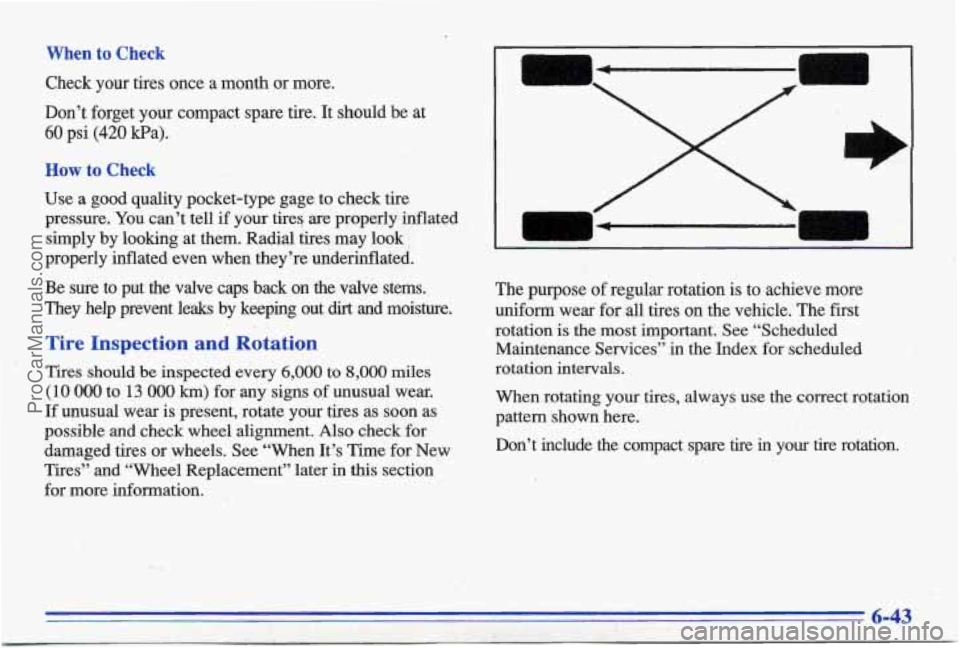
When to Check
Check your tires once a month or more.
Don’t forget your compact spare tire. It should be at
60 psi (420 kPa).
How to Check
Use a good quality pocket-type gage to check tire
pressure. You can’t tell
if your tires are properly inflated
simply by looking at them. Radial tires may look
~
properly inflated even when they’re underinflated.
Be sure to put the valve caps back on the valve stems.
They help prevent l&s by keeping out
dirt and moisture.
Tire Inspection and Rotation
Tires should be inspected every 6,000 to 8,000 miles
(10 000 to 13 000 km) for any signs of unusual wear.
If unusual -wear
is present, rotate your tires as soon as
possible and check wheel alignment.
Also check for
damaged tires or wheels. See “When It’s Time for Ne,w
Tires” and “Wheel Replacement” later in
this section
for more information. The purpose
of regular rotation is to achieve more
uniform wear for all tires
on the vehicle. The first
rotation is the most
important. See “Scheduled
Maintenance Services”
in the Index for scheduled
rotation
intervals.
When rotating your tires, always use the correct rotation
pattern shown here.
Don’t include the compact spare tire
in your tire rotation.
,. .
ProCarManuals.com
Page 289 of 387

After the tires have been rotated, adjust the front and
rear inflation pressures as shown
on the Tire-Loading
Infannation label. Make certain that all wheel nuts
are properly tightened. See “Wheel Nut Torque”
in
the Index.
I --I
Rust or dirt on a wheel, or on the pads to which
it is fastened, can make wheel nuts become loose
after
a time. The wheel could come off and cause
an accident. When you change a wheel, remove
any rust or dirt from places where the wheel
attaches
to the vehicle. In an emergency, you can
use
a cloth or a paper towel to do this; but be
sure to use
a scraper or wire brush later, if you
need
to, to get all the rust or dirt off. (See
“Changing a Flat Tire” in the Index.) When
It’s Time for New Tires
One
way to tell when it’s
time for new tires
is to
check the treadwear
indicators, which will
appear when your tires have
only 1/16 inch (1.6 rnm) or
less
of tread remaining.
YOU need a new tire if any of the following statements
are true:
0 YOU can see the indicators at three or more places
around the tire.
0 you can see cord or fabric showing through the
tire’s rubber.
The tread or sidewall is cracked, cut or snagged deep
enough to show cord
or fabric.
The tire has a bump, bulge OT split.
6-44
ProCarManuals.com
Page 290 of 387
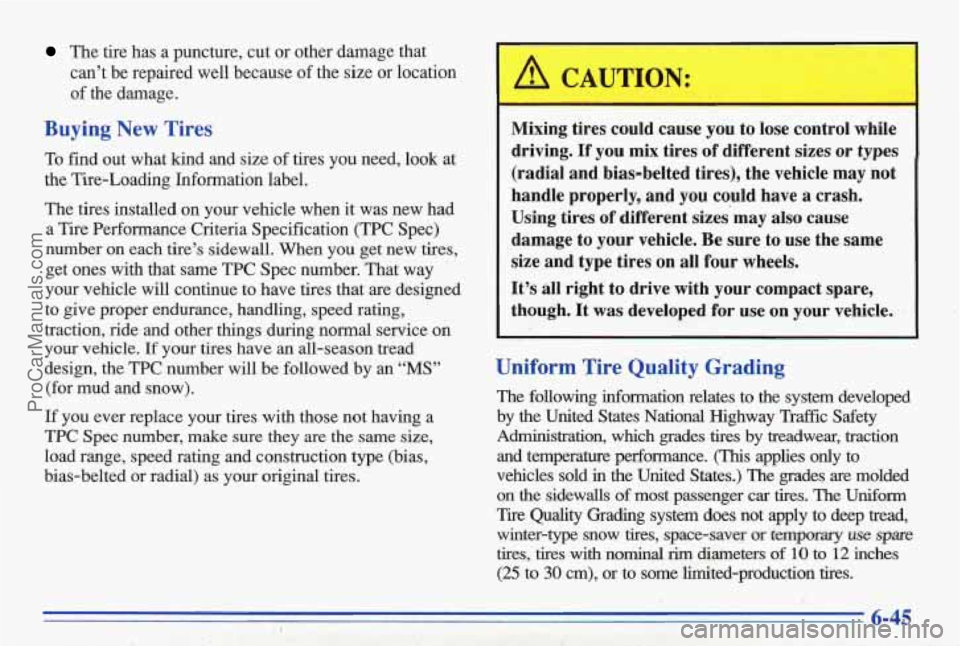
The tire has a puncture, cut or other damage that
can’t be repaired well because of the size or location
of the damage.
Buying New Tires
To find out what kind and size of tires you need, look at
the Tire-Loading Information label.
The tires installed on your vehicle when it was new had
a Tire Performance Criteria Specification (TPC Spec)
number on
each tire’s sidewall. When you get new tires,
get ones with that same TPC Spec number. That way
your vehicle will continue to have tires that are designed
to give proper endurance, handling, speed rating,
traction, ride and other things during normal service
on
your vehicle. If your tires have an all-season tread
design, the TPC number will be followed by an
“MS”
(for mud and snow).
If you ever replace your tires with those not having a
TPC Spec number, make sure they are the same size,
load range, speed rating and construction type (bias,
bias-belted or radial) as your original tires.
A CAUTION:
Mixing tires could cause you to lose control while
driving.
If you mix tires of different sizes or types
(radial and bias-belted tires), the vehicle may not
handle properly, and you could have a crash.
Using tires
of different sizes may also cause
damage to your vehicle. Be sure to use the same
size and type tires on
all four wheels.
It’s all right to drive with your compact spare,
though. It was developed
for use on your vehicle.
Uniform Tire Quality Grading
The following information relates to the system developed
by the United States National Highway Traffic Safety
Administration, which grades tires by treadwear, traction and temperature performance.
(Th.zs applies only to
vehicles sold in the United States.) The grades are molded
on the sidewalls of most passenger car tires. The Uniform
Tire Quality Grading system does not apply to deep tread, winter-type snow tires, space-saver
or temporary use spare
tires, tires with nominal rim diameters of 10 to 12 inches
(25 to 30 cm), or to some limited-production tires.
I 6-45
ProCarManuals.com